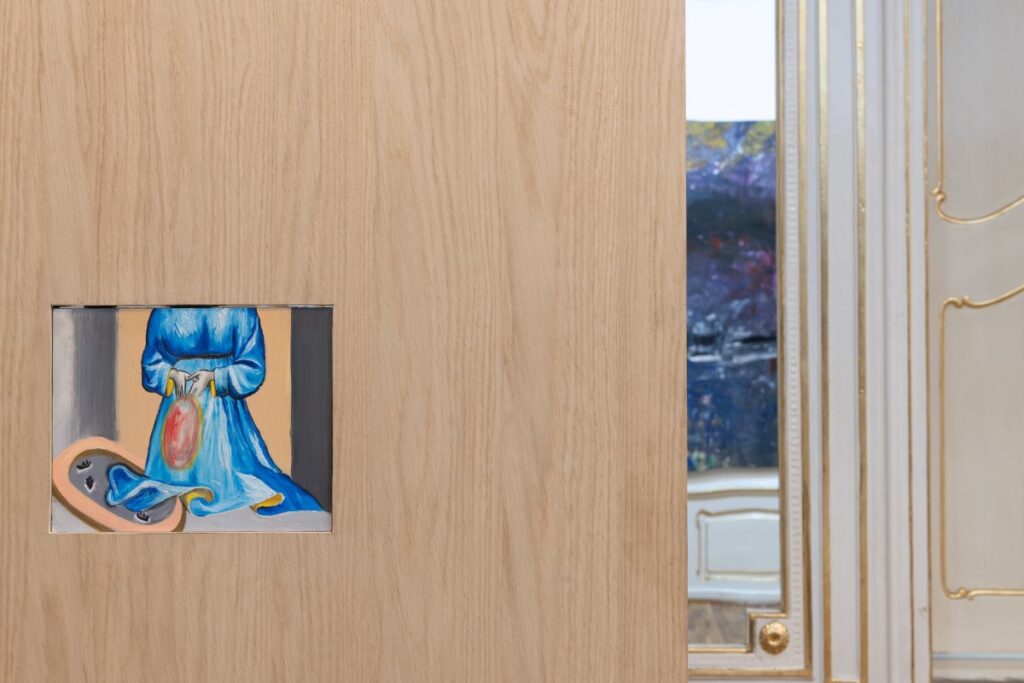SOTTOBOSCO
15 November 2018
Artists: The Rustling of the Forest and the Wind: Enzo Cucchi | Ioan Sbârciu Special guest: Markus Lüpertz; On the Scarlet Canvas of the Sky: Georgeta-Olimpia Bera | Kudor Duka István | Cristian Lăpușan | Anca Bodea Mureșan | Andrea Salvino; In the Crystal Coolness of the Morning: Veronica Bisesti | Gagyi Botond | Dario Carratta | Giovanni De Cataldo | Luca Grechi | Mihai Guleș | Andrei Ispas | Tincuța Marin | Alexandra Mureșan | Oana Nastasache | Emma Păvăloaia | Jacopo Pinelli | Lucian Popăilă | Marcel Rusu | Andrei Sclifos
Curated by: Antonello Tolve
Location: Museum of Art Cluj-Napoca
The Bánffy Palace – The Museum of Art | Cluj-Napoca, in collaboration with UAD – The University of Art and Design in Cluj-Napoca, the Faculty of Letters | the Department for Roman Languages and Literatures within the Babeș-Bolyai University, Richter Fine Art Gallery (Rome) and Sector 1 Gallery (Bucharest) has the pleasure to announce Sottobosco an exhibition trilogy curated by Antonello Tolve, which will open on Thursday, November 15th, with the occasion of professor Ioan Sbârciu’s 70th birthday celebration.
Like a knot that bonds distances over the seas, like a red guiding thread that connects different generations to a magmatic warp when one might foresee the genuineness of a meeting, the freshness of hospitality or the desire to outline a joyful state of intimacy, the cultural adventure which has started in Cluj-Napoca with Sottobosco / The Underwood is a gentle breeze bringing good-vibes from beneficial realms.
Like a knot that bonds distances over the seas, like a red guiding thread that connects different generations to a magmatic warp when one might foresee the genuineness of a meeting, the freshness of hospitality or the desire to outline a joyful state of intimacy, the cultural adventure which has started in Cluj-Napoca with Sottobosco / The Underwood is a gentle breeze bringing good-vibes from beneficial realms.
The indispensable lack of a universal sense to be followed, the breeze of a sylvan labyrinth, the poetic place filled with paths to be crossed, where to misplace the words but, at once, to discover the evocative force of the sign, these all become the center of an unpredictable exhibition space, of a continuously unfulfilled search, of a track whose narrative aspect connects the human being to culture, to thinking, to memories, emerging changed, altered by the spaces of the memory.
Considering the three exhibitions – each significantly connected to an expression of the wood as it appears in Grazia Deledda’s novel entitled Il vecchio della montagna (The Old Man of the Mountains) – we notice that painting becomes a language of the world, a philosophical discourse, a therapy whose treatment provides first aid to the general disorder of the concepts that influence the human being, becomes a continuous excavation watering and fertilizing the dry and dehydrated surface of the mind (Wittgenstein).
Born as a result of the meeting between two explosive personalities (Enzo Cucchi and Ioan Sbârciu), this exhibition represents a constructive confrontation between different generations and, in the same time, a rhizomatic weawing (not at all chaotic) of the creative worlds, united by the same red thread, by the same idea over painting understood as a form of research, of performance, made by a lucid hand that draws the feelings of humanity within the shadows of the light.
The Rustling of the Forest and the Wind
The itinerary unveils a dialogue between two masters of the same generation, Enzo Cucchi and Ioan Sbârciu, exponents of a complete painting, that outlines, on this occasion, the encounter between a micro and a macro sylvan universe, installing bindings between signs, which seem to come in sight only to mingle with the grim sound of vision (Cucchi) within ample chromatic surfaces, sometimes of sharp green, others of pale green like the playful morning wind, gently blowing through the trees (Sbârciu).
A first fascinating itinerary is rendered where one might get lost in the darkness of the forest, within actions of fast and vivacious mastery, or might lose in between strong linguistic fireworks, which allow glimpses underneath the shadows and appearances (Leopardi) of the warm spectrum of things.
On the Scarlet Canvas of the Sky
The second exhibition within the project is represented by a generation of artists born between the 70’s and the 80’s – Georgeta-Olimpia Bera, Kudor Duka István, Cristian Lăpușan, Anca Bodea Mureșan and Andrea Salvino – causing a moment of lucid analysis of the characters within the artistic creation, whose modus operandi touches reality with a reflexive attitude, bent over intimacy, memory and time in painting.
We are talking here about a pentagon whose vocal character is situated on the discrete background of the underwood in order to highlight the hijacked silence throughout the day, the shadows wandering through the evening mist, the fresh air of every day’s life, the tragic and the horror of history.
This second phase, dedicated to the underwood, gives us the pictorial shades of a series of already formed artists, of a series of professors involved in research and, in the same time, preoccupied with art teaching aiming at the proliferation of new generations of artists.
In the Crystal Coolness of the Morning
Polyphonic, refined and dense, opened to new generations from the Italian artistic background and from the Painting School of Cluj, the 3rd exhibition, discovered along this linguistic journey, is a project connected with the generations of artists born at the end of the 80’s and the first half of the 90’s. The transition towards the new generations of the Painting School of Cluj and of the Italian Art School – Veronica Bisesti, Gagyi Botond, Dario Carratta, Giovanni De Cataldo, Luca Grechi, Mihai Guleș, Andrei Ispas, Tincuța Marin, Alexandra Mureșan, Oana Năstăsache, Emma Păvăloaia, Jacopo Pinelli, Lucian Popăilă, Marcel Rusu, Andrei Sclifos – represents, within this journey, an inevitable meditation, not necessarily over the present, but mostly over the process of the creative world’s rejuvenation, making ways within the artworld in order to discover its own voice, to draw deep forms in the matter (sinoli of matter and form), to become trait d’union between the past and something that we can no longer call past.
The exhibition will end with a publication (IDEA publishing house) which, tout court, will cross over the limits of a catalogue in order to become an exhibition itself, not a documenting space, but the space of creative action and of enthusiastic discoveries.
Considering the three exhibitions – each significantly connected to an expression of the wood as it appears in Grazia Deledda’s novel entitled Il vecchio della montagna (The Old Man of the Mountains) – we notice that painting becomes a language of the world, a philosophical discourse, a therapy whose treatment provides first aid to the general disorder of the concepts that influence the human being, becomes a continuous excavation watering and fertilizing the dry and dehydrated surface of the mind (Wittgenstein).
Born as a result of the meeting between two explosive personalities (Enzo Cucchi and Ioan Sbârciu), this exhibition represents a constructive confrontation between different generations and, in the same time, a rhizomatic weawing (not at all chaotic) of the creative worlds, united by the same red thread, by the same idea over painting understood as a form of research, of performance, made by a lucid hand that draws the feelings of humanity within the shadows of the light.
The Rustling of the Forest and the Wind
The itinerary unveils a dialogue between two masters of the same generation, Enzo Cucchi and Ioan Sbârciu, exponents of a complete painting, that outlines, on this occasion, the encounter between a micro and a macro sylvan universe, installing bindings between signs, which seem to come in sight only to mingle with the grim sound of vision (Cucchi) within ample chromatic surfaces, sometimes of sharp green, others of pale green like the playful morning wind, gently blowing through the trees (Sbârciu).
A first fascinating itinerary is rendered where one might get lost in the darkness of the forest, within actions of fast and vivacious mastery, or might lose in between strong linguistic fireworks, which allow glimpses underneath the shadows and appearances (Leopardi) of the warm spectrum of things.
On the Scarlet Canvas of the Sky
The second exhibition within the project is represented by a generation of artists born between the 70’s and the 80’s – Georgeta-Olimpia Bera, Kudor Duka István, Cristian Lăpușan, Anca Bodea Mureșan and Andrea Salvino – causing a moment of lucid analysis of the characters within the artistic creation, whose modus operandi touches reality with a reflexive attitude, bent over intimacy, memory and time in painting.
We are talking here about a pentagon whose vocal character is situated on the discrete background of the underwood in order to highlight the hijacked silence throughout the day, the shadows wandering through the evening mist, the fresh air of every day’s life, the tragic and the horror of history.
This second phase, dedicated to the underwood, gives us the pictorial shades of a series of already formed artists, of a series of professors involved in research and, in the same time, preoccupied with art teaching aiming at the proliferation of new generations of artists.
In the Crystal Coolness of the Morning
Polyphonic, refined and dense, opened to new generations from the Italian artistic background and from the Painting School of Cluj, the 3rd exhibition, discovered along this linguistic journey, is a project connected with the generations of artists born at the end of the 80’s and the first half of the 90’s. The transition towards the new generations of the Painting School of Cluj and of the Italian Art School – Veronica Bisesti, Gagyi Botond, Dario Carratta, Giovanni De Cataldo, Luca Grechi, Mihai Guleș, Andrei Ispas, Tincuța Marin, Alexandra Mureșan, Oana Năstăsache, Emma Păvăloaia, Jacopo Pinelli, Lucian Popăilă, Marcel Rusu, Andrei Sclifos – represents, within this journey, an inevitable meditation, not necessarily over the present, but mostly over the process of the creative world’s rejuvenation, making ways within the artworld in order to discover its own voice, to draw deep forms in the matter (sinoli of matter and form), to become trait d’union between the past and something that we can no longer call past.
The exhibition will end with a publication (IDEA publishing house) which, tout court, will cross over the limits of a catalogue in order to become an exhibition itself, not a documenting space, but the space of creative action and of enthusiastic discoveries.
Looking for more?
Address
Băiculești 29 Street, District 1, 013193, Bucharest, Romania
Opening Hours
Tuesday – Saturday, 2 – 7 PM
Sunday – Monday, by appointment only
Newsletter
Sign up to receive the latest news on the gallery’s artists
Sector 1 Gallery © 2023. All Rights Reserved.
Privacy Policy

